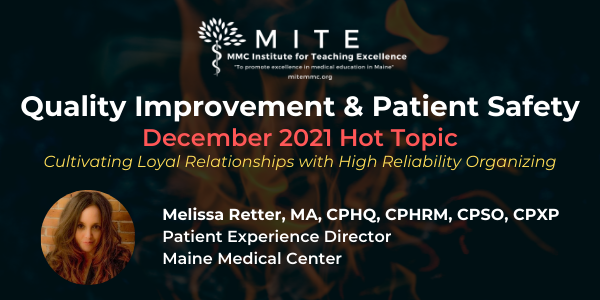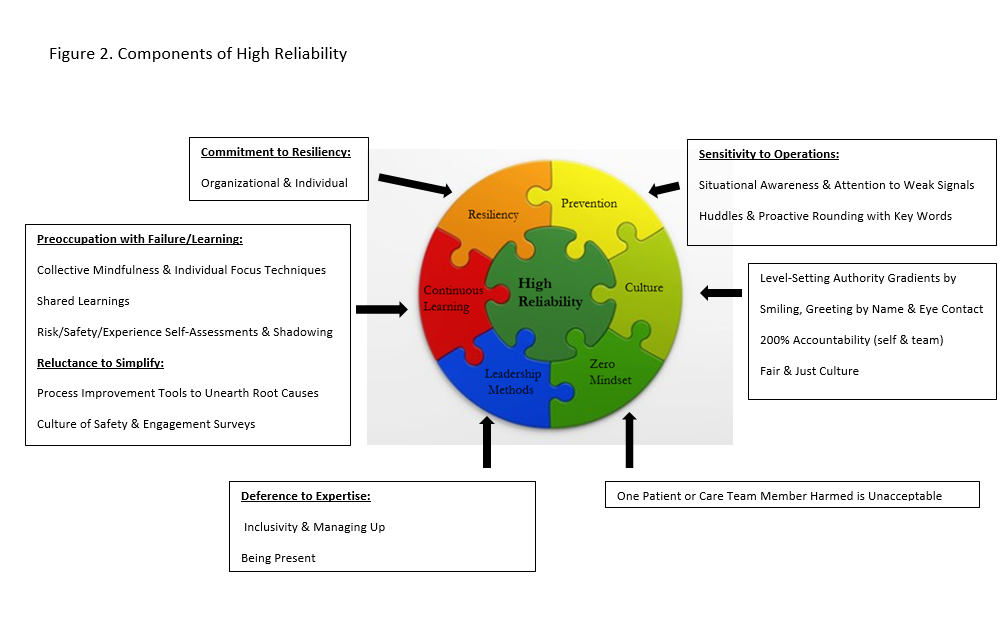
Cultivating Loyal Relationships with High Reliability Organizing
Melissa Retter, MA, CPHQ, CPHRM, CPSO, CPXP
Patient Experience Director
Maine Medical Center
Learning Objectives:
1.Recognize the distinction between patient experience and human experience
2.Describe how harm can erode human experiences and negatively impact trust and loyalty
3.Identify principles of high reliability organizing that facilitate positively memorable human experiences
When we ponder the essence of relationships that are established in healthcare settings, we are unable to do so without succumbing to the humble and simple realization that we are human beings caring for human beings. Our shared human condition results in a mutual vulnerability to the myriad of circumstances that we encounter in life. Our patients experience a wide range of influences that impact their well-being just as our care team members do. The Beryl Institute defines patient experience as, ‘the sum of all interactions shaped by an organization’s culture that influence patient perceptions across the continuum of care’ (2021). Beyond the sum of all interactions, patient experiences are defined by individual interactions they have with all other human beings. Together, we are empowered to co-create a consistently safe, compassionate, and positively memorable culture that arises when trusting relationships are formed. It behooves us to expand our mindset to think about relationship-centered care. Our engagement has a profound impact on the caliber of the relationships that we cultivate with our patients and their families.
Trusting and loyal relationships with our patients, colleagues and ultimately, organization, are eroded when we experience harm. While acknowledging the importance of physical harm, we focus our attention now on a few examples of the effects of psychological and emotional harm (Figure 1). Our patients may experience harm if they feel that we are discriminating against them and/or they perceive a lack compassion, courtesy, or respect. As a result, they may not receive indicated care or they may articulate anger towards caregivers. They may experience a desire to seek care elsewhere in the future, and share their negative experience with others, effectively harming our organizational reputation. Our colleagues may experience harm if they perceive a leader in the organization is controlling or condescending. They may feel unimportant and be less prone to speak up in the future when they identify safety concerns or have ideas about how to improve care. They may decide to seek employment elsewhere. Even worse, they may become disengaged and reckless during the delivery of patient care. It is essential to note that nurturing relationships requires more than the mere absence of harm. We must prevent harm and consistently deploy best practices that are grounded in the science of organizing for high reliability.
When it comes to preventing harm and cultivating a care environment and work environment, there are practices within the realm of high reliability organizing that promote establishment of compassionate and positively memorable human experiences. Operating in a highly reliable manner does not imply that we are error free! Weick and Sutcliffe (2001) aptly reflect on how errors occur in complex systems. They highlight the processes and structures coupled with increased workload, distractions, over-confidence, and time pressures that impact the behavior of individuals and groups at the front line. Key tenants of high reliability include a commitment to the right culture, deferent and present leadership, continuous learning, organizational and individual resiliency, prevention and a zero tolerance for human harm (Figure 2). Reduction of power distances between patients, families, and colleagues by making eye contact, smiling, and greeting others by their preferred name creates a welcoming and inclusive culture. Commitment to the right culture also involves holding ourselves and our team members accountable for compassionate treatment. Noteworthy hallmarks of high reliability include a focus on preventing harm, a reluctance to simplify, a preoccupation with learning and deference to expertise. We seek to mitigate damage that can fracture trusting relationships with others by sharing human experience stories. We must go to the sites of care delivery to host listening labs, attend team huddles, and humbly defer to the knowledge of the workers at the front line. Lastly, our well-being as care team members is of paramount importance. When we take care of ourselves and we feel appreciated, we become resilient. When we are resilient, we can be mindful and present in each fleeting moment that we are blessed to share with others. We are empowered to tap into our passion as caregivers, and co-author consistent and mutually delightful human experiences. The result is devoutly loyal patients and care team members.
Figure 1. Harmful Communication and Behavior Outcomes*
| Harmful Communication and/or Behavior | Feelings | Potential Patient Outcomes | Potential Care Team Member Outcomes |
| Discriminating | Inequality, Anger, Resentment | Diminished Access to Indicated Care
Long-Term Impact on Prognosis Future Care Sought Elsewhere Share Negative Experience with Others |
Restricted Access to Job Opportunities
Reduced Desire to Speak Up for Safety Disengagement Reduced Well-Being Departure from Employer |
| Condescending | Belittlement, Unimportance, Indignancy | Reluctance to Speak Up with Concerns
Diminished Partnership with Care Future Care Sought Elsewhere Share Negative Experience with Others |
Reduced Desire to Speak Up for Safety
Disengagement Reduced Well-Being Departure from Employer |
| Controlling | Frustration, Rebellion, Complacency, Apathy | Non-Compliance with Care Plan
Adversarial Relationships Future Care Sought Elsewhere Share Negative Experience with Others |
Reckless and Unsafe Challenging Behavior
Disengagement Reduced Well-Being Departure from Employer |
| Dismissing and/or Ignoring | Isolation, Desperation, Unimportance, Frustration | Reluctance to Speak Up with Concerns
Diminished Partnership with Care Future Care Sought Elsewhere Share Negative Experience with Others |
Reduced Desire to Speak Up for Safety
Disengagement Reduced Well-Being Departure from Employer |
| Lacking Compassion, Courtesy and/or Respect | Anger, Disappointment, Sadness, Unimportance | Diminished Partnership with Care
Future Care Sought Elsewhere Share Negative Experience with Others |
Reckless and Unsafe Challenging Behavior
Disengagement Reduced Well-Being Departure from Employer |
Retter, M. 2021
*Examples above are not all-inclusive as additional ways harm impacts patients and team members exist.

References
- Cook, R. and Woods, D. 1994. Operating at the Sharp End: The Complexity of Human Error. Healthcare Performance Improvement, LLC, All Rights Reserved.
- Schultz, E. A. and Lavenda, R. H. 2005. Cultural Anthropology: A Perspective on the Human Condition. 7th New York: Oxford University Press.
- Weick, K.E. and Sutcliffe. 2001. Managing the Unexpected: Assuring High Performance in an Age of Complexity. San Francisco: Jossey-Bass Publishers.
Want to earn CE Credits? Click Here
Download PDF